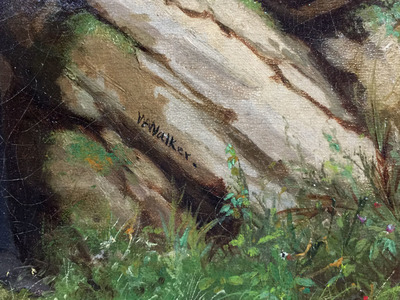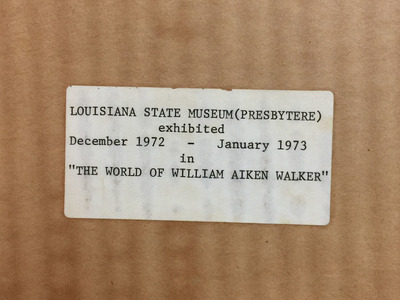-
William Aiken Walker 1839-1921
-
Paintings
-
- William Aiken Walker
- 1839-1921
- Galveston Artist
- Size: 20 x 16
- Frame: 24 x 20
- Medium: Oil
- "Southern Gentleman"
- View details
- Contact for Price & Info
-
-
Biography
William Aiken Walker 1839-1921 Galveston Artist
Walker was born and reared in Charleston, South Carolinas. At age eleven he exhibited a painting in an 1850 fair sponsored by the South Carolina Institute in Charleston. Little is known presently of his academics or art education; he may have studied at Dusseldorf in later years. At the beginning of the Civil War in 1861, Walker enlisted as a private in the Second Palmetto Regiment, a Charleston militia unit, and was discharged at Richmond, Virginia, about three months afterward on a surgeon's certificate of disability, based evidently on an injury or illness of some kind. He worked thereafter as a civilian draftsman for the Corps of Engineers, Confederate States Army, sketching the Charleston defenses and drawing maps. He sketched an eyewitness view of the bombardment of Fort Sumter by Union ironclads in 1863 and another picture of the resulting ruins. Walker left Charleston about the time the city fell to Union forces in early 1865 and returned after the war. In 1868 he moved to Baltimore where he painted and taught languages. After a visit to New York City, he traveled to Havana in 1869 to work as a photographer's colorist. By 1871, he was again in Baltimore. After living for a time in Louisville, Kentucky, he began a peripatetic life of paintings in the South: Galveston (1874-75), San Antonio (1876), Augusta, Georgia (1879-80), Vicksburg, Mississippi (1880), Greenville, Mississippi (1882-83), and other locations, supporting himself selling his picturesque, realistic, Southern scenes to tourists and local inhabitants. Beginning in 1876, Walker regularly spent a part of the year in New Orleans and after 1883 he painted in the summers in the Blue Ridge Mountains of North Carolina, interspersed with periodic visits with relatives in Charleston. After 1897, he made Florida his winter home and Arden, North Carolina, a summer retreat. Walker died at his nephew's home in Charleston. Walker was well known for the realistic portrayals of rural blacks and Southern plantation life, but his body of work included a large number of portraits, marines, landscapes, city views, still lifes, and action pictures. Two of his works were lithographed by Currier and Ives.
Exhibitions: South Carolina Institute Fair (1850, 1859); Maryland Academy of Art, Baltimore (1871); Louisville (Kentucky) Industrial Exposition (1872); Northern, Central and South American Exposition, New Orleans (1885-86); Art Association of New Orleans (1886-1892); Southern Art Union (1890); Tulane University, New Orleans (1892); World's Columbian Exposition, Chicago (1893); Louisiana Purchase Exposition, St. Louis (1904); Bland Gallery, New York (1940); Exhibition of Southern Genre Paintings by William Aiken Walker, Didiers, New Orleans (1972); The Democratic Art, Amon Carter Museum of Western Art, Fort Worth (1979 traveling exhibition); Art and Artists of the South: Robert P. Coggins Collection, Cheekwood Fine Arts Center, Nashville, Tennessee (1984); The Texas Collection (1984); Texas Seen/Texas Made (1986), San Antonio Museum of Art; Art for History's Sake: The Texas Collection of the Wittie Museum, San Antonio (1993); The Sunny South: The Art of William Aiken Walker, Gerold Wunderlich & Company, New York (1995).


